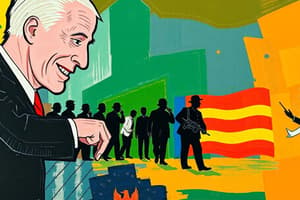Podcast
Questions and Answers
What is the Brain Trust?
What is the Brain Trust?
- A group of financial advisors
- Specialists in law, economics, and welfare who advised President Roosevelt (correct)
- A political party
- A military strategy
What were the main goals of the New Deal?
What were the main goals of the New Deal?
To solve the problems of the Great Depression by providing relief for the unemployed and stimulating economic recovery.
The first hundred days of Roosevelt's administration are known as the ______.
The first hundred days of Roosevelt's administration are known as the ______.
Hundred Days
What did the Glass-Steagall Banking Reform Act create?
What did the Glass-Steagall Banking Reform Act create?
What was the purpose of the Civilian Conservation Corps (CCC)?
What was the purpose of the Civilian Conservation Corps (CCC)?
What was the main aim of the Agricultural Adjustment Administration (AAA)?
What was the main aim of the Agricultural Adjustment Administration (AAA)?
The Dust Bowl was caused by floods.
The Dust Bowl was caused by floods.
What achievements are associated with the Tennessee Valley Authority (TVA)?
What achievements are associated with the Tennessee Valley Authority (TVA)?
What did the Social Security Act provide for?
What did the Social Security Act provide for?
What did the Wagner Act establish?
What did the Wagner Act establish?
Match the following individuals to their contributions:
Match the following individuals to their contributions:
Who was Franklin Delano Roosevelt?
Who was Franklin Delano Roosevelt?
What was Keynesianism based on?
What was Keynesianism based on?
The ______ Act of 1935 was a significant achievement of the New Deal.
The ______ Act of 1935 was a significant achievement of the New Deal.
Who created the National Union for Social Justice?
Who created the National Union for Social Justice?
Flashcards are hidden until you start studying
Study Notes
Key Terms and Definitions
- Brain Trust: Group of young university professors advising President Franklin D. Roosevelt on New Deal policies, representing expertise in law, economics, and welfare.
- New Deal: Roosevelt's series of policies in the 1930s aimed at addressing the Great Depression, focusing on relief, recovery, and reform to expand the welfare state.
- Hundred Days: The initial period of Roosevelt's presidency (March 9 - June 16, 1933), marked by the passage of numerous reform bills by Congress to launch the New Deal.
- Glass-Steagall Banking Reform Act: Established the Federal Deposit Insurance Corporation (FDIC) in 1933, ensuring bank deposits and promoting banking stability.
Government Programs and Acts
- Civilian Conservation Corps (CCC): Launched in 1933, this program hired unemployed young men for environmental projects, laying the groundwork for the post-World War II environmental movement.
- National Recovery Administration (NRA): An early New Deal initiative focused on industrial and labor assistance through centralized planning, including wage monitoring and fair competition standards.
- Agricultural Adjustment Administration (AAA): Created in 1933 to increase agricultural prices by incentivizing farmers to reduce crop production, aimed at enhancing farmers’ economic power.
- Dust Bowl: Severe drought in the 1930s that devastated the Great Plains, leading to mass displacement of families, particularly "Okies" and "Arkies" moving to California.
Notable New Deal Initiatives
- Tennessee Valley Authority (TVA): A groundbreaking public works program providing electric power, jobs, housing, and environmental enhancements to the Tennessee Valley in 1933.
- Social Security Act (1935): Landmark legislation establishing unemployment and old-age insurance funded by payroll taxes, a core component of the New Deal framework.
- Wagner Act (1935): Also known as the National Labor Relations Act, this law secured the rights of workers to unionize and collectively bargain, establishing the National Labor Relations Board.
- Fair Labor Standards Act (1938): Regulated minimum wages and maximum working hours in interstate commerce while excluding many workers, particularly in agriculture and services.
Key Figures in the New Deal
- Franklin Delano Roosevelt: Elected in 1932, he enacted the New Deal, pushed for economic reforms, and served four terms before the 22nd Amendment limited future presidencies.
- Eleanor Roosevelt: Active First Lady who championed civil rights, women's rights, and social reforms, significantly influencing New Deal policies.
- Harry L. Hopkins: Social worker and leader of key relief administrations, instrumental in distributing funds and creating jobs during the Great Depression.
- Father Charles Coughlin: A prominent critic of the New Deal, he advocated for monetary reform and nationalized banking through his radio show and the National Union for Social Justice.
Social and Economic Reformers
- Francis E. Townsend: Proposed a government-funded old-age pension plan, forming ideas that contributed to the Social Security Act.
- Huey P. Long: Louisiana senator promoting his "Share Our Wealth" program, which advocated for wealth redistribution through high taxes on the wealthy.
- Frances Perkins: The first female cabinet member and labor secretary, integral in shaping labor policies and union engagement in the New Deal.
- Mary McLeod Bethune: Civil rights leader and head of the Office of Minority Affairs, focused on extending New Deal benefits to African Americans.
- Robert F. Wagner: New York senator crucial in passing significant New Deal legislation, including the Labor Relations Act and the National Industrial Recovery Act.
Economic Theories and Controversies
- Court-Packing Plan: Roosevelt's unsuccessful attempt to expand the Supreme Court to safeguard New Deal reforms, reflecting political tensions over judicial authority.
- Keynesianism: Economic theory advocating for active government intervention through deficit spending and tax adjustments to stimulate demand and economic recovery.
Studying That Suits You
Use AI to generate personalized quizzes and flashcards to suit your learning preferences.




